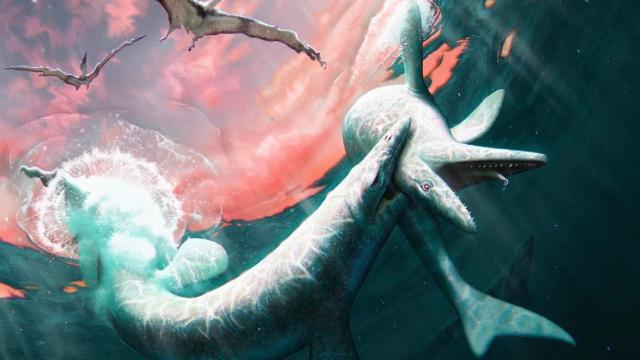No aquatic reptiles today can match mosasaurs, ocean-dwelling creatures of the Cretaceous period that looked something like a cross between a whale and a shark. Now, a group of researchers have discovered a mosasaur that they believe bridges the gap between two iconic species in the ancient group.
The newly described mosasaur is Jormungandr walhallaensis, a 24-foot-long 7.3-meter-long) lizard with sharp teeth and a stumpy tail that inhabited the Western Interior Seaway, a body of water hundreds of miles across that stretched from the Arctic to the Gulf of Mexico. The team’s research describing the find was published today by the American Museum of Natural History.
Jormungandr refers to a giant serpent in Norse mythology, the son of the god Loki. The team decided to name the reptile Jormungandr because of its findspot, near Walhalla, North Dakota—the Norse Valhalla being the afterlife of Norse warriors killed in combat.
“If you put flippers on a Komodo dragon and made it really big, that’s what it would have looked like,” said Amelia Zietlow, a biologist at the American Museum of Natural History’s Richard Gilder Graduate School and the study’s lead author, in a museum release.
The specimen consists of a nearly complete skull, seven cervical vertebrae and several dorsal vertebrae, 11 ribs, as well as some yet-to-be-identified post-cranial bits. The specimen was dated to the late Cretaceous period based on a layer of bentonite below the bones. The animal lived about 80 million years ago, some 15 million years before the age of dinosaurs would come to an end.
“This fossil is coming from a geologic time in the United States that we don’t really understand,” said study co-author Clint Boyd, a paleontologist with the North Dakota Geological Survey, in the same release. “The more we can fill in the geographic and temporal timeline, the better we can understand these creatures.
According to the research team, Jormungandr shares features with Clidastes, a smaller mosasaur that inhabited the Western Interior Seaway farther south, in what is today Kansas, and Mosasaurus, a massive, 50-foot-long (15.2-meter-long) mosasaur that coexisted with Tyrannosaurus rex. The team believes that Jormungandr arrived on the Cretaceous scene before Mosasaurus. It is one of the northernmost mosasaurs found in the Western Interior Seaway, and expands the known range of the animals into Campanian North America, according to the team.
“As these animals evolved into these giant sea monsters, they were constantly making changes,” Zietlow said. “This work gets us one step closer to understanding how all these different forms are related to one another.”
Mosasaurs were a diverse group of predators. The term “mosasaur” was coined before “dinosaur,” and yet research is still catching up with all the eccentricities of the marine reptiles. In 2020, a team found evidence that mosasaurs laid eggs, and research presented last year at the Society of Vertebrate Paleontology’s annual meeting indicated that mosasaurs could open their jaws very wide, and may have been venomous. Earlier this year, a different team described a mosasaur species with teeth ridged like a Phillips head screwdriver, perhaps to crunch through shell or fish bones.
Jormungandr appears in the in-betweens of the known mosasaur record, giving researchers a helpful new branch on their family tree. With any luck, more mosasaurine finds will fill out the tree even more, clarifying the relationships of these ancient marine lizards.
